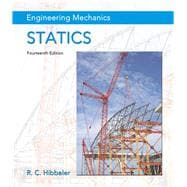About This Book
Engineering Mechanics: Statics, 14th Edition
Engineering Mechanics: Statics, 14th Edition, is a comprehensive textbook designed for students and educators in introductory engineering mechanics courses. This book excels in providing a clear and thorough presentation of the theory and application of engineering mechanics, making it a go-to resource for those looking to understand the fundamental principles of statics.
Who Uses It?
Primarily, this book is used by students and instructors in introductory engineering mechanics courses at the college and university levels. It's also a valuable resource for anyone interested in understanding the basics of statics, including professionals looking to refresh their knowledge or expand their understanding of mechanical principles.
History and Editions
The 14th edition of Engineering Mechanics: Statics has been updated to address user feedback, incorporating the latest research and discussions on engineering mechanics. This edition includes detailed updates on problem-solving techniques and real-world applications, ensuring that students have a solid foundation in statics before moving on to more advanced topics. The book has been a staple in engineering education for over a decade, with each edition building upon the previous one to provide a more comprehensive understanding of statics.
Author and Other Works
Russell C. Hibbeler is the author of Engineering Mechanics: Statics. Hibbeler is renowned for his ability to explain complex mechanical concepts clearly and simply, making the subject accessible to students at all levels. He has written numerous textbooks on engineering mechanics, including dynamics and materials science, and his works are widely used in engineering education.
Key Features
- Comprehensive Coverage: The book covers core concepts in statics, including detailed explanations and examples.
- Interactive Digital Learning Experience: The 14th edition includes an interactive digital learning experience with features like search, highlight, and note-taking capabilities.
- Instant Feedback: Students can receive instant feedback on assignments, helping them track their progress and understand the material better.
- Study Tools: The book is designed with study tools that make it easy for students to create flashcards and review material effectively.
Detailed Information
ISBNs and Formats
- Hardcover: ISBN-13: 9780133918922
- eTextbook: ISBN-13: 9780133918939
- Loose-leaf: ISBN-13: 9780133918946
Publication Details
- Publisher: Pearson
- Publication Date: July 1, 2020
- Number of Pages: 672
- Language: English
- Item Weight: 2.904 pounds
- Dimensions: 8.25" wide x 9.50" long x 1.00" tall
Other Editions and Formats
- 13th Edition: Available through Pearson and other retailers
- ISBN-13: 9780133918922
- ISBN-13: 9780133918939 (eTextbook)
- ISBN-13: 9780133918946 (Loose-leaf)
Related ISBNs:
- 13th Edition: ISBN-13: 9780133918922
- eTextbook (14th Edition): ISBN-13: 9780133918939
- Loose-leaf (14th Edition): ISBN-13: 9780133918946
Note: The ISBNs listed are accurate and specific to the editions mentioned.









